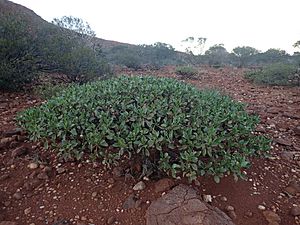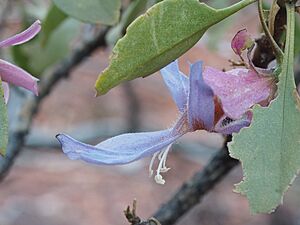Eremophila flaccida facts for kids
Quick facts for kids Eremophila flaccida |
|
|---|---|
 |
|
| Eremophila flaccida flaccida growing near Mount Augustus | |
| Scientific classification | |
| Genus: |
Eremophila (plant)
|
| Species: |
flaccida
|
Eremophila flaccida is a beautiful flowering plant that belongs to the figwort family, called Scrophulariaceae. This plant is endemic to Western Australia, which means it naturally grows only in that area and nowhere else in the world. It is a low, spreading shrub with shiny, sticky leaves and large, eye-catching flowers. There are two types, or subspecies, of Eremophila flaccida. One is quite common and found in many places, while the other is rare and known from only a few spots.
Contents
What Does Eremophila flaccida Look Like?
Eremophila flaccida is a shrub that usually grows less than 1 meter (about 3 feet) tall. However, it can spread out quite wide, often reaching 3 or 4 meters (about 10 to 13 feet) across! Its branches and leaves are very sticky and shiny. This is because they have a lot of resin, which is a natural sticky substance.
Its Leaves and Branches
The leaves of this plant grow one after another along the stems. They are shaped like an egg and are about 30 to 95 millimeters (1 to 4 inches) long. They are also 4 to 30 millimeters (0.2 to 1.2 inches) wide. The leaves are glabrous, meaning they are smooth and have no hairs. They are also sticky and shiny. Each leaf usually has a clear stalk about 12 to 24 millimeters (0.5 to 1 inch) long. The bottom of the leaf has a raised line in the middle, and sometimes the edges have a few small teeth.
Its Unique Flowers
The flowers of Eremophila flaccida hang down by themselves from where the leaves join the stem. They are on a smooth stalk that is 30 to 45 millimeters (1.2 to 1.8 inches) long. Each flower has 5 reddish-purple, egg-shaped sepals. Sepals are like small leaves that protect the flower bud. These sepals overlap and are different sizes, with the longest being 24 to 31 millimeters (about 1 inch) and the shortest 15 to 25 millimeters (about 0.6 to 1 inch). The outside of the sepals is a bit hairy, but the inside is smooth.
The petals are 40 to 50 millimeters (1.6 to 2 inches) long and join together at the bottom to form a tube. The tube itself is brown, but the tips of the petals are purplish-blue. Two of these petal tips spread out, looking a bit like rabbit ears! The outside of the tube and both sides of the petal tips are covered with short hairs. Inside the tube, there are many long, soft hairs. The flower has 4 stamens, which are the parts that produce pollen. These stamens stick out beyond the end of the petal tube.
This plant flowers from June to September. After the flowers, it produces dry, oval-shaped fruits with a pointed end. These fruits are about 6 to 9 millimeters (0.2 to 0.4 inches) long.
How Was Eremophila flaccida Named?
This plant was officially described for the first time by a scientist named Robert Chinnock in 2007. He published his description in a book about Eremophila plants. The second part of its scientific name, flaccida, comes from a Latin word that means "drooping." This name was chosen because the flowers of this plant hang downwards.
In the same book, Robert Chinnock also described two different types, or subspecies, of Eremophila flaccida. These names are now accepted by the Australian Plant Census, which keeps track of all Australian plants:
- Eremophila flaccida subsp. flaccida: This type has egg-shaped leaves with a clear stalk.
- Eremophila flaccida subsp. attenuata: This type has long, thin leaves that gradually narrow towards the base and do not have a clear stalk.
Where Does Eremophila flaccida Grow?
Eremophila flaccida subsp. flaccida likes to grow in stony clay soil. It is quite common in areas near the Hamersley Range, including Mount Augustus. These areas are in the Gascoyne and Pilbara regions of Western Australia.
The other type, subspecies attenuata, is much rarer. It is found in only a few places between Byro Station and Dairy Creek Station. These locations are in the Murchison region.
Is Eremophila flaccida Protected?
The Western Australian Government Department of Parks and Wildlife keeps track of how common or rare plants are. Eremophila flaccida subsp. flaccida is considered "not threatened," which means it is common enough and not in danger.
However, subspecies attenuata is listed as "Priority Three." This means it is not very well known and is found in only a few spots. While it is not in immediate danger of disappearing, it is still important to keep an eye on it and protect its habitat.
Growing Eremophila flaccida in Your Garden
Because of its rounded shape and large, pretty flowers that look a bit like orchids, Eremophila flaccida is a very nice plant for gardens. However, it can be quite tricky to grow new plants from its seeds or from cuttings (small pieces of the plant).
A good way to grow it is by grafting. This is a special method where a part of Eremophila flaccida is joined onto the Myoporum rootstock (the root system of another plant). Grafting allows Eremophila flaccida to grow in many different types of soil. It can grow well in full sun or in partial shade. This plant is also very good at handling dry conditions, so it doesn't need a lot of water. However, it can be affected by frost. If there's a frost, the plant might turn black, but it usually recovers its leaves and its nice rounded shape.


